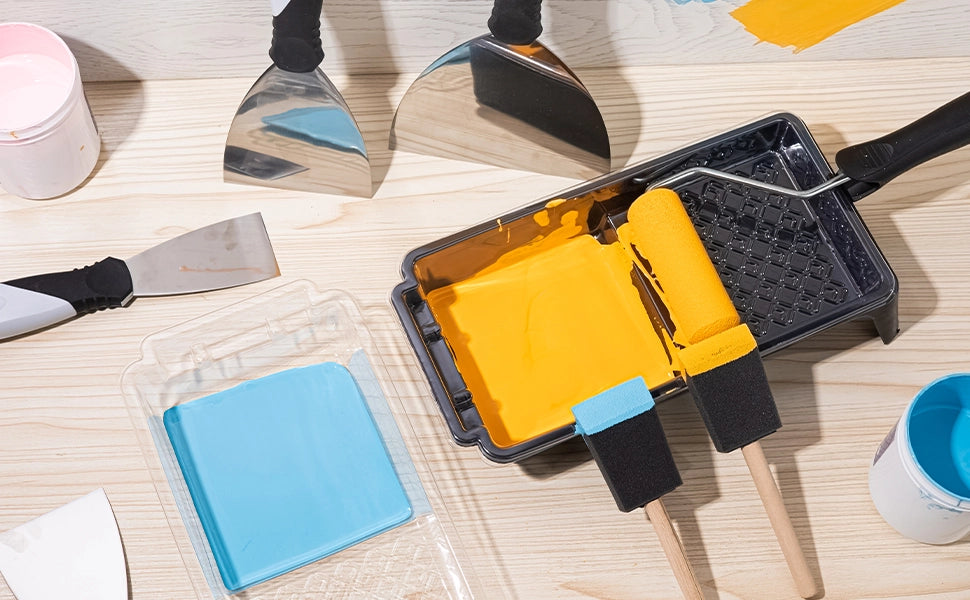Painting a ceiling might seem straightforward, but it’s one of the most technically challenging DIY projects. A poorly executed ceiling job leads to neck strain, uneven color, and dreaded "holidays" (missed spots). Drawing from 15 years of professional painting experience, this guide reveals the best practices for flawless results and exposes the hidden mistakes that ruin 80% of DIY ceiling projects.
Tools You’ll Need
- Mister Rui Telescoping Extension Pole (Adjustable 4–12 ft)
- Angled Cut-In Brush (2.5” for precision edges)
- High-Density Roller Cover (3/8” nap for smooth ceilings, 1/2” for textured)
- Thick-Napped Roller Frame (Mister Rui’s QuickLock system recommended)
- LED Headlamp (500+ lumens to spot missed areas)
- Drywall Primer (Oil-based for stain blocking)
- Ceiling Paint (Flat or matte finish to minimize imperfections)
Step 1: Prep Work – The Foundation of Perfection
A. Clear the Room
- Remove furniture or cover with plastic sheeting (NOT cloth – dust sticks to fabric).
- Use blue painter’s tape to protect walls and trim.
B. Repair Ceiling Flaws
- Fix cracks with elastomeric caulk (flexes with temperature changes).
- For popcorn ceilings:
- Mist with water before scraping to reduce asbestos risk (pre-1980 homes).
- Patch with USG Sheetrock® Texture Spray.
C. Clean the Surface
- Wipe with TSP substitute (trisodium phosphate alternative) to degrease.
- Sand glossy surfaces with 320-grit sandpaper to improve adhesion.
Step 2: Prime Strategically
When to Prime:
- New drywall: PVA primer (seals porous surfaces)
- Water stains: Shellac-based primer (blocks stubborn marks)
- Color changes: Tinted primer (e.g., gray for dark paint)
Pro Tip: Add Floetrol to primer for smoother application on textured ceilings.
Step 3: Master the Cutting-In Technique
- Load the angled brush 1/3 up the bristles.
- Paint a 3” strip along the ceiling-wall junction.
- Blend edges with a dry brush technique to avoid ridges.
- Work in 4’x4’ sections to maintain a wet edge.
Avoid This Mistake: Don’t press too hard – it forces paint under the tape.
Step 4: Roll Like a Seasoned Painter
Optimal Pattern:
- Start in a corner, rolling in a W or M shape to distribute paint evenly.
- Reload the roller after 3–4 passes (ceiling paint dries 30% faster than wall paint).
Pressure Control:
- First pass: Moderate pressure to fill texture grooves.
- Final pass: Light pressure for uniform finish.
Lighting Hack: Shine the headlamp at a low angle to reveal missed spots.
Step 5: Avoid These 7 Deadly Ceiling Painting Mistakes
-
Wrong Paint Sheen:
- Mistake: Using eggshell/satin (highlights flaws).
- Fix: Flat paint absorbs light; matte is washable.
-
Overextending the Roller
- Mistake: Stretching paint too thin causes “starving” (uneven coverage).
- Fix: Limit roller width to 3 ft per load.
-
Ignoring Drying Time
- Mistake: Applying second coat too soon (peeling risk).
- Fix: Wait 2–4 hours (check manufacturer’s instructions).
-
Poor Neck Positioning
- Mistake: Craning neck leads to wobbling strokes.
- Fix: Use the Mister Rui extension pole and stand sideways.
-
Wrong Roller Direction
- Mistake: Rolling randomly creates light-reflect variations.
- Fix: Roll toward the main light source (window/light fixture).
-
Skipping the “Boxing” Step
- Mistake: Mixing paint cans mid-job causes color mismatch.
- Fix: “Box” all paint into a 5-gallon bucket and stir thoroughly.
-
Using Cheap Brushes
- Mistake: Bristle fallout sticks to the ceiling.
- Fix: Invest in Mister Rui’s synthetic brushes (zero shedding).
Pro Maintenance Tips
- Dust Monthly: Use a lambswool duster on an extension pole.
- Spot Clean: Dab stains with a magic eraser – never scrub!
- Touch-Up Formula: Keep leftover paint in a Mason jar (lasts 2+ years).
Case Study: A Nightmare Turned Triumph
A Chicago homeowner attempted painting a vaulted ceiling without primer or proper lighting. Result: 60% repaint cost due to uneven sheen and bristle debris. After following this guide with Mister Rui tools, their second attempt lasted 5+ years with zero touch-ups.



0 comments